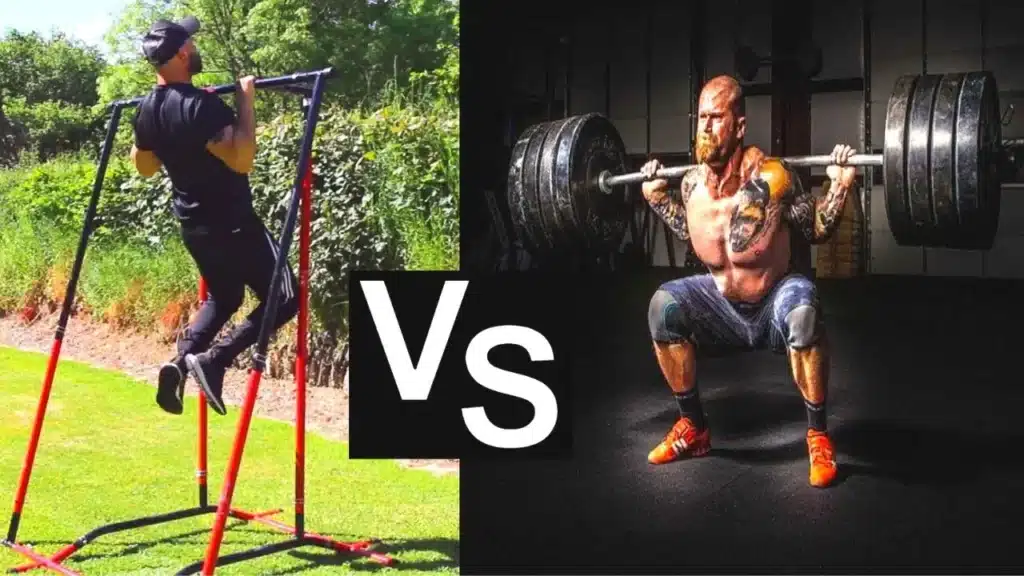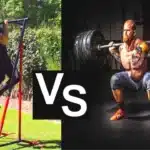As I stood in front of the mirror, flexing my newly defined muscles, I couldn’t help but reflect on the journey that brought me here.
Five years ago, I was a scrawny college student, torn between the allure of the weight room and the simplicity of bodyweight exercises.
Little did I know that this personal dilemma would lead me down a path of discovery, not just about fitness, but about the very nature of strength and human potential.
The question that kickstarted my journey is one that continues to spark heated debates in gyms, online forums, and fitness circles worldwide: which is better cathesteics or weight lifting?
As someone who has experienced the transformative power of both, I’m here to share my insights, backed by science and seasoned with personal anecdotes, to help you navigate this fitness crossroad.
Calisthenics and Weightlifting Defined
Before we dive into the nitty-gritty of this fitness face-off, let’s establish a clear understanding of what we’re comparing:
Calisthenics: The Art of Bodyweight Mastery
Calisthenics, derived from the Greek words “kallos” (beauty) and “sthenos” (strength), is a form of strength training that relies primarily on your body weight for resistance. It encompasses a wide range of exercises, from basic moves like push-ups and squats to advanced feats of strength such as muscle-ups and human flags.
Weightlifting: The Iron Path to Power
Weightlifting, on the other hand, involves using external weights – be it dumbbells, barbells, kettlebells, or machines – to provide resistance.
It includes various disciplines such as powerlifting, Olympic weightlifting, and bodybuilding, all united by the principle of progressively lifting heavier loads.
The Great Debate: Calisthenics vs Weightlifting
Now that we’ve set the stage, let’s break down this comparison across several key factors that matter most to fitness enthusiasts:
1. Muscle Building: The Battle for Gains
Weightlifting: Traditionally, weightlifting has been hailed as the ultimate muscle-building method. The ability to incrementally increase weight allows for consistent progressive overload, a key principle in hypertrophy (muscle growth).
I remember the thrill of adding another plate to the bar during my squats, watching my legs transform from twigs to tree trunks over months of dedicated training.
Dr. Brad Schoenfeld, a renowned expert in muscle hypertrophy, states: “The key factor in muscle growth is not the type of resistance but rather the application of progressive overload and training to muscular failure.”
Calisthenics: While some skeptics argue that “calisthenics can’t build muscle,” my experience and recent research suggest otherwise.
Advanced calisthenics moves like one-arm push-ups and front levers can build impressive strength and muscle. However, progress can be slower and may plateau earlier for some muscle groups.
A study published in the Journal of Strength and Conditioning Research found that both calisthenics and traditional resistance training led to similar improvements in muscle strength and endurance when matched for effort.
Personal Experience: When I first started with calisthenics, I was skeptical about its muscle-building potential.
But after mastering moves like weighted pull-ups and pistol squats, I saw significant gains, especially in my back, chest, and legs. The key was learning to progressively overload bodyweight exercises through leverage, added weight, or increased volume.
2. Fat Loss: Shedding Pounds and Sculpting Physiques
Both calisthenics and weightlifting can be effective for fat loss when combined with proper nutrition. The key is the intensity and volume of your workouts.
Calisthenics: Often involves more full-body movements and can be easily adapted into high-intensity interval training (HIIT) formats, which are excellent for fat burning.
The versatility of calisthenics allows for quick transitions between exercises, keeping your heart rate elevated and maximizing calorie burn.
Weightlifting: Can be structured for fat loss through circuit training or metabolic resistance training. The afterburn effect (EPOC – Excess Post-exercise Oxygen Consumption) can be significant, especially with heavy compound lifts like deadlifts and squats.
A study in the Journal of Strength and Conditioning Research found that high-intensity resistance training was more effective for fat loss compared to traditional cardio when combined with a calorie-restricted diet.
Personal Anecdote: During my fitness journey, I experimented with both methods for fat loss. I found that a calisthenics-based HIIT routine was incredibly effective for quick fat-burning sessions, especially when I was short on time.
However, heavy weightlifting sessions seemed to keep my metabolism fired up for longer, which was great for sustained fat loss over time.
3. Convenience and Accessibility: Breaking Down Barriers
Calisthenics: One of the biggest advantages of calisthenics is its accessibility. You can do it anywhere, anytime, with minimal or no equipment. This makes it ideal for travelers or those who prefer working out at home.
I recall a backpacking trip through Southeast Asia where my calisthenics routine kept me fit without ever stepping foot in a gym. From beach push-ups in Thailand to park bar muscle-ups in Vietnam, the world became my playground.
Weightlifting: Typically requires access to a gym or a substantial home setup, which can be a barrier for some. The equipment costs and space requirements can be significant if you’re looking to set up a home gym.
Real-world Application: The COVID-19 pandemic highlighted the adaptability of calisthenics practitioners. While many gym-goers struggled to maintain their routines, those versed in bodyweight training easily adapted to home workouts.
4. Skill Development: Strength Meets Artistry
Calisthenics: Excels in developing body awareness, balance, and functional strength. Mastering skills like handstands or muscle-ups can be incredibly rewarding and offers a unique blend of strength and artistry.
The skill component of calisthenics often leads to a strong, supportive community. I’ve made lifelong friends at calisthenics parks, bonding over the shared struggle of achieving our first muscle-up or human flag.
Weightlifting: Focuses more on raw strength and power. While it does require skill to perform lifts correctly, the skill component is generally less emphasized compared to calisthenics. However, Olympic weightlifting is an exception, requiring high levels of skill, mobility, and coordination.
Personal Growth: My journey into calisthenics opened up a whole new world of movement. Learning to control my body in space through skills like handstands not only improved my strength but also my proprioception and overall body awareness, which carried over into other aspects of my life, from improved posture to better performance in team sports.
5. Injury Risk and Joint Health: Safeguarding Your Body
Both forms of training carry injury risks if performed incorrectly. However, they differ in their impact on joints:
Calisthenics: Generally lower impact on joints, especially for beginners. Advanced moves can be challenging but often promote joint health through increased mobility work. The progressive nature of calisthenics allows for a gradual increase in joint stress, potentially reducing the risk of overuse injuries.
Weightlifting: Can put more stress on joints, especially with heavy loads. Proper form is crucial to prevent injury. However, when done correctly, weightlifting can strengthen bones and connective tissues, potentially reducing the risk of osteoporosis later in life.
A study in the Journal of Strength and Conditioning Research found that both bodyweight and free-weight exercises activated stabilizing muscles to a similar degree, suggesting both can contribute to joint stability when performed correctly.
Personal Insight: In my early weightlifting days, I experienced some knee pain from heavy squats. Incorporating calisthenics leg exercises like pistol squats and shrimp squats not only alleviated the pain but also improved my overall leg strength and stability.
6. Cardiovascular Health: Pumping Iron vs. Pumping Blood
While both forms of exercise can improve cardiovascular health, their approaches differ:
Calisthenics: Often incorporates more dynamic, full-body movements that can elevate heart rate quickly. Circuit-style calisthenics workouts can provide an excellent cardiovascular workout while building strength.
Weightlifting: Traditional weightlifting may not provide as much cardiovascular benefit, but techniques like circuit training or high-volume, low-rest workouts can significantly impact heart health.
A study in the International Journal of Exercise Science found that both resistance training and high-intensity interval training (which can be done with calisthenics or weights) improved cardiovascular health markers in sedentary adults.
My Experience: I’ve found that incorporating burpees and mountain climbers into my calisthenics routine provides a cardio kick that’s hard to match with traditional weightlifting. However, high-rep Olympic lifts like clean and jerks can also get my heart racing in no time.
7. Cost-Effectiveness: Investing in Your Health
Calisthenics: Generally more cost-effective as it requires minimal equipment. A pull-up bar and some resistance bands can go a long way. This low barrier to entry makes it accessible to people of all economic backgrounds.
Weightlifting: Can be more expensive due to gym memberships or the cost of setting up a home gym. However, a basic set of adjustable dumbbells can provide a good starting point for home weightlifting.
Budget-Friendly Fitness: During my college years, when money was tight, calisthenics was a lifesaver. I transformed my physique using nothing but a door-frame pull-up bar and the jungle gym at a local park.
8. Functional Strength: Real-World Application
Calisthenics: Excels in building functional strength that translates well to everyday activities. Movements like pull-ups, push-ups, and squats mimic real-life motions, potentially making daily tasks easier.
Weightlifting: Also builds functional strength, especially with compound movements like deadlifts and overhead presses. The ability to handle external loads can be particularly beneficial for tasks requiring heavy lifting.
A study in the Journal of Strength and Conditioning Research found that functional training (which can include both calisthenics and weightlifting elements) improved performance in daily activities more than traditional resistance training alone.
Functional Fitness in Action: I noticed the real-world benefits of my training when helping a friend move apartments. Years of pull-ups and muscle-ups made carrying heavy boxes up stairs feel like a breeze, while my weightlifting friends excelled at lifting the heaviest furniture.
9. Body Composition Changes: Sculpting Your Physique
Both calisthenics and weightlifting can dramatically alter body composition, but they may do so in slightly different ways:
Calisthenics: Tends to create a lean, toned physique with excellent muscle definition. It’s particularly effective at developing the core, back, and arm muscles due to the nature of many bodyweight exercises.
Weightlifting: Allows for more targeted muscle growth and can be more effective for building overall mass, especially in the legs and chest where it’s harder to provide sufficient resistance with bodyweight alone.
A study in the European Journal of Applied Physiology showed that bodyweight training could be as effective as weight training for muscle hypertrophy when matched for effort.
Personal Transformation: My own body has gone through phases with both training styles. Weightlifting gave me more overall mass, especially in my legs and chest. Calisthenics, on the other hand, chiseled out my abs and back like nothing else. The key was finding a balance that gave me the best of both worlds.
10. Mental Health Benefits: Exercise for the Mind
Both forms of exercise have significant mental health benefits, but they can affect the mind in different ways:
Calisthenics: The skill-based nature of many calisthenics exercises can provide a sense of achievement and boost self-esteem.
The meditative aspect of controlling your body through space, as in handstands or L-sits, can also reduce stress and improve focus.
Weightlifting: Provides a tangible sense of progress as weights increase, which can be a powerful motivator. The release of endorphins during heavy lifting sessions can also combat depression and anxiety.
A review in the Journal of Clinical Medicine found that both resistance training and bodyweight exercises had positive effects on mental health, including reduced symptoms of depression and anxiety.
Mindful Movement: Personally, I’ve found that the flow state achieved during a complex calisthenics routine brings a unique sense of calm and focus. On the other hand, the primal satisfaction of lifting heavy weights has often been my go-to stress reliever after a tough day.
The Hybrid Approach: Best of Both Worlds
After years of experience and research, my conclusion is this: the most effective approach for many people is a combination of both calisthenics and weightlifting.
This allows you to reap the benefits of each method while minimizing their individual limitations.
A hybrid approach might look like this:
- Monday: Upper body weightlifting (bench press, rows, shoulder press)
- Tuesday: Lower body calisthenics (pistol squats, lunges, calf raises)
- Wednesday: Cardio and core (running, planks, leg raises)
- Thursday: Upper body calisthenics (pull-ups, dips, handstand practice)
- Friday: Lower body weightlifting (squats, deadlifts, leg press)
- Saturday: Full body calisthenics or weightlifting circuit
- Sunday: Rest or light activity (yoga, walking)
This approach allows for the progressive overload of weightlifting while developing the body control and functional strength of calisthenics.
Tailoring Your Approach: Factors to Consider
When deciding between calisthenics, weightlifting, or a hybrid approach, consider the following factors:
- Goals: Are you aiming for maximum muscle growth, functional strength, or skill development?
- Available Resources: Do you have access to a gym or prefer working out at home or outdoors?
- Time Commitment: How much time can you dedicate to working out each week?
- Personal Preferences: Do you enjoy the challenge of mastering bodyweight skills or the satisfaction of lifting heavy weights?
- Current Fitness Level: Beginners might find calisthenics more approachable, while those with a strength base might prefer the measurable progress of weightlifting.
- Long-term Sustainability: Which method are you more likely to stick with consistently?
Addressing Common Myths and Misconceptions
As we wrap up this comprehensive comparison, let’s address some common myths:
- Myth: Calisthenics can’t build muscle.
Truth: Advanced calisthenics can build significant muscle, especially when progressively overloaded.
- Myth: Weightlifting always leads to a bulky physique.
Truth: Your diet and specific training program determine your physique more than the mere act of lifting weights.
- Myth: Calisthenics is only for beginners.
Truth: Many calisthenics skills take years to master and require incredible strength and control.
- Myth: Weightlifting is bad for your joints.
Truth: When done with proper form, weightlifting can strengthen joints and connective tissues.
- Myth: You can’t lose fat with weightlifting alone.
Truth: Weightlifting, combined with proper nutrition, can be very effective for fat loss.
Conclusion: Your Fitness, Your Choice
As we reach the end of this deep dive into the world of calisthenics and weightlifting, remember that the best workout is the one you’ll stick to consistently.
Whether you choose calisthenics, weightlifting, or a mix of both, consistency and progressive overload are key to achieving your fitness goals.
My journey has taught me that there’s no one-size-fits-all approach to fitness. The beauty of this field is in its diversity and the opportunity for continuous learning and growth.
As you embark on or continue your fitness journey, listen to your body, set clear goals, and don’t be afraid to experiment with different training styles.
Remember, your perfect fitness routine is out there – it might just be a combination you haven’t tried yet! Keep pushing, keep learning, and most importantly, enjoy the process.
Your body is capable of amazing things, whether you’re defying gravity with a planche or setting a new personal record in the squat rack.







